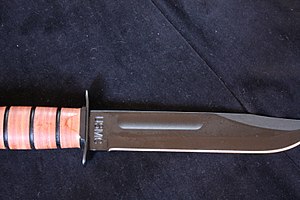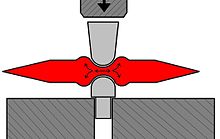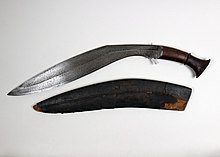|
Fuller (groove) A fuller is a rounded or beveled longitudinal groove or slot along the flat side of a blade (e.g., a sword, knife, or bayonet) that serves to both lighten and stiffen the blade, when considering its reduced weight.[1] Cutting or grinding a fuller into an existing blade will decrease its absolute stiffness due to the removal of material, but much of the strength remains due to the geometry of its shape. When the groove is forged into the blade, it achieves a similar reduction in weight with a relatively small reduction in strength without the wasted material produced by grinding.[citation needed] When impressed during forging, it may be made using a blacksmithing tool that is also called a fuller, a form of spring swage. When combined with optimal[vague] distal tapers,[2] heat treatment and blade tempering, a fullered blade can be 20% to 35% lighter than a non-fullered blade. The ridges and groove created by the fuller are comparable to an I-beam's flanges and web; this shape aims to optimize the strength and stiffness for a given quantity of material, particularly in the cutting direction.[citation needed] A fuller is often used to widen a blade during smithing or forging. Fullers are sometimes inaccurately called blood grooves or blood gutters. Channelling blood is not the purpose of a fuller.[3][4][5] EtymologyThe term "fuller" is from the Middle English fuliere, meaning 'one that fulls [pleats] cloth'. It is derived from the Latin word fullo. The first recorded use of the term in relation to metal working is 1587.[6] The first recorded use of the term to describe a groove or channel in a blade is 1967.[7] Tool As a blacksmithing tool, a fuller is a type of swage, a tool with a cylindrical or beveled face used to imprint grooves into metal. Fullers are typically three to six inches long. If a groove is to be applied to both sides of the steel, two fullers may be used at the same time, sandwiching the workpiece in the middle. Often, one fuller will have a peg that holds it securely in the anvil, while the other fuller will have a handle and a flat head, for striking with a hammer. A blade being fullered will generally be slowly pulled through the fullers as it is being hammered, displacing material to the side (rather than removing it) and thereby creating ridges on either side of a groove. These ridges may be hammered flat, widening the blade, or they are often shaped with other swages, increasing the strength of the blade both by creating thicker areas in its cross section and lateral ridges that resist lengthwise deflection. In addition to being used to "draw out" steel, hammering a short block into a long bar, fullers are also used in the production of items such as hinges and latches, plow parts, and horseshoes.[8] Japanese bladesIn Japanese swordsmithing, fullers have a rich tradition and terminology, enough that there are separate terminologies for the top (hi, usually pronounced as bi when used as the second member of a compound) and bottom (tome) ends of the feature.
The kukri The Nepali kukri has a terminology of its own, including the "aunlo bal" (finger of strength/force/energy), a relatively deep and narrow fuller near the spine of the blade, which runs (at most) between the handle and the corner of the blade, and the "chirra", which may refer either to shallow fullers in the belly of the blade or a hollow grind of the edge, and of which two or three may be used on each side of the blade.[9] Gallery
See alsoReferences
Further reading
|



